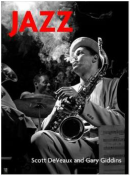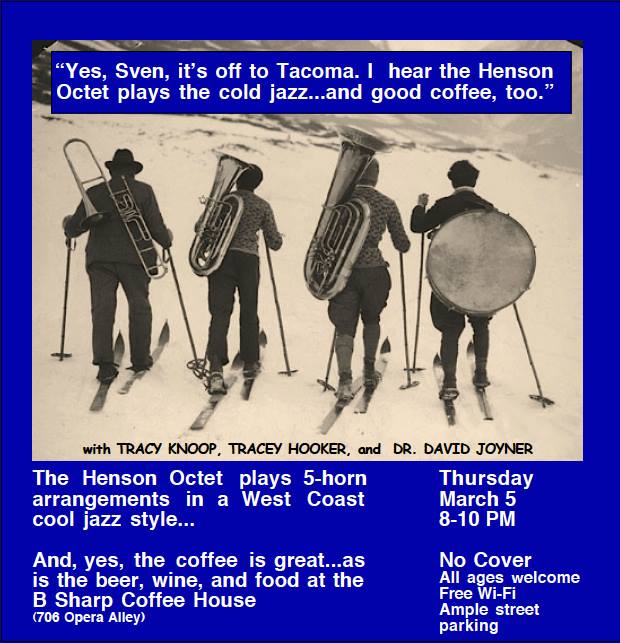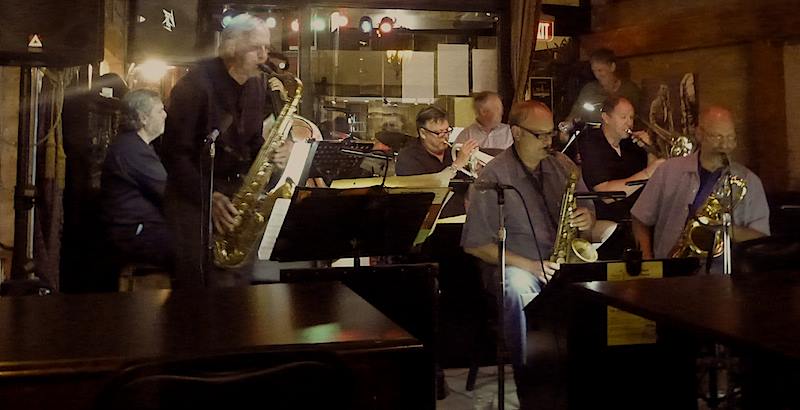 (Photo credit: Amazon.com)
(Photo credit: Amazon.com) Patrons settled into typical coffee shop furnishings, a mixture of small tables, bar-height tables, a variety of chairs, and sofas. This added to the laid-back atmosphere, though I wish more thought had been put into the layout; when guests arrived after the break they seated themselves at a high table in the front, blocking my view. Though music is often thought of as an auditory experience, the behaviors of the musicians greatly added to the character of the show, and I was disappointed to not enjoy the full effect in the second part.
Music began promptly at 8 p.m. and the performers clearly enjoyed their playing. They were conducted by enthusiastic gestures from Keith Henson while he also played his tenor saxophone. Conducting consisted of hand-waving, pointing out the order of solos, and twirling his horn to pull each song to a unified close. The musicians wore casual attire, as did most of the audience.
According to the notes on the set list that Henson provided me, "Java Junction" was performed as written. I was most struck by the impressive dynamic shifts. During this piece I became aware of Bill Duris' facial expression. While he played the string bass, he held his cheeks and lips together tensely, as if he needed an embouchure. I noted that his face relaxed during keys solos, and I found it interesting that he appeared to feel the music in that physically imitative way.
In "Bluescope" Tracey Hooker’s fantastic trumpet solo emotionally struck high notes. By comparison, the electronic voice of Dr. David Joyner's keyboard solo could have been better chosen to suit the excitement I expected to feel. (Joyner's best moment was later in the set, with "Sonny R.")
It was Tracy Knoop's turn to shine with the alto saxophone solo in "Case de Luz." He performed with a frenzied speed that seemed pleasantly out of control. It proceeded for many measures and appeared to continue past a point when the trumpet thought it would take over, but Knoop wasn't ready to cede the song! Eventually he passed the melody along to other instruments, including both horn and rhythm sections. As a whole, this was clearly a favorite of the musicians, who grooved with every Latin-inspired note, and the oft-applauding audience.
"Our Delight" was the only selection of the evening that disappointed me, and it was unfortunate that it followed an invigorating piece. The letdown for me was the baritone saxophone solo, the timbre of which warmed me thoroughly, but the rhythm and note selection didn't seem to relate to the swinging accompaniment.
The next piece, "Easy Living," was thoughtful. Slow and featuring the trumpet, it placed emphasis on dissonant chords that created moments of tension and release. There was a particularly fun section where the saxophones (all three) taunted Hooker with a series of block chords. This interplay brought both excitement and humor to the piece, and it was all the more impressive when we learned that the group was sight-reading it (and even more impressed to learn that this is a common practice for them)!
Joyner's solos in "Pierce Arrow" interested me because the voice reminded me of a vibraphone. I think it suited the piece, though I would be curious how the piece would differ if played on a traditional piano. Regardless, the solos were short and dueled with Steve Bentley on his drum set. These musical rivalries were fun to witness, as the performers seem to be enjoying the experience as much as the listeners. The use of stop time was effective in emphasizing the spirit of the ensemble supporting the duel. To my delight, Joyner finished the piece with some "Rhapsody in Blue" riffs.
Hooker's solo in "Morpo" was stunning and bright with brass. At this point I was convinced the advertisement of him being a "Grammy Award-winning trumpeter" is well-deserved, and it was my good fortune to find him playing in a coffee shop in Tacoma.
Hooker traded out for a flugelhorn in "Daquilo Que Eu Sei," bringing a mellower brass sound to the ensemble. However, my untrained ear had to work hard to hear the difference in brassiness between this instrument and his trumpet in a later piece. Perhaps what most caught my attention was that he was playing a bigger instrument so my ears anticipated a difference in tone.
"Carnival" was another festive Latin-feeling piece, and the entire octet put their playing and movement wholly into it. Hooker played a long solo "story" on top, followed by Knoop, whose change in timbre changed the story to an exciting new narrative. While Knoop was playing, Hooker walked over to play physically alongside him, adding an appealing visual component to the dueling. This was followed by Bentley's best solo of the evening, and the piece ended with a few bars of unison playing that was impressive for its precision.
The evening ended with "Lotus Bud," a piece that I found odd for departure due to its slow nature. Nevertheless, it was sweet to the ears and the keys again seemed to mimic a vibraphone.
By the end of the two-hour performance (including one short break), the cafe was comfortably full, but not standing-room-only. It appeared that most of the audience was white and over 50, with a couple of tables of 20- or 30-somethings, and a handful of African-Americans, Latinos, and Asians (so far as could be ascertained visually). With the exception of a man occupying a table with reams of paperwork at the back, everybody seemed to be there for the purpose of enjoying the performance.
I enjoyed the diversity of selections and playing during the evening and would wholeheartedly recommend this group to my friends, with the caveat that they select seating that allows them full view of the interplay between musicians.
- Tracey Hooker, trumpet
- Keith Henson, tenor saxophone
- Tracy Knoop, alto saxophone
- Derek Nelson, baritone saxophone
- Eric Stevens, trombone
- Dr. David Joyner, keys
- Bill Duris, standup bass
- Steve Bentley, percussion
Set List (arrangements by Keith Henson):
- "Groovin' Easy" by Sammy Nestico
- Java Junction" by Harry Warren
- "Bluescope" by Sammy Nestico
- "Case de Luz" by Shorty Rogers
- "Our Delight" by Tadd Dameron
- "Easy Living" by Ralph Rainger and Leo Robin
- "Pierce Arrow" by Dave Wheeler
- "Gospel Jazz" Shout by Dave Wheeler
- "Pirouette" by Shorty Rogers
- "Morpo" by Shorty Rogers
- "Sonny R" by Gary Carney
- "Daquilo Que Eu Sei" by Ivan Lins
- "Jazz Goes to Siwash" by Bill Holman
- "Carnival" by Dan Smith
- "Lotus Bud" by Shorty Rogers










